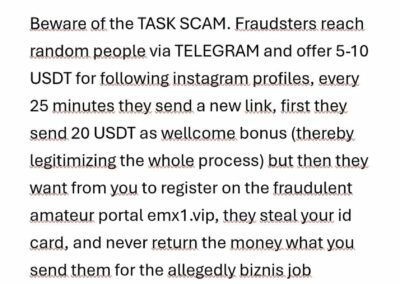Safeguarding Against Digital Task Scams
Tips for Protecting Yourself Online
In today’s digital age, the rise of remote work and online freelancing has created opportunities for individuals to earn income by completing digital tasks. However, amidst the plethora of legitimate platforms and opportunities, there exists the risk of falling victim to digital task scams. In this blog post, we’ll delve into the phenomenon of digital task scams, the tactics employed by scammers, and actionable strategies individuals can implement to protect themselves from fraudulent schemes.
Understanding Digital Task Scams
Digital task scams involve individuals or organizations posing as legitimate employers or clients, offering payment in exchange for completing various digital tasks. These tasks may include data entry, online surveys, social media management, or other virtual assignments. However, instead of receiving payment for their work, victims may end up providing free labor, compromising their personal information, or falling victim to financial fraud.
How Digital Task Scams Work
-
False Job Offers: Scammers post fake job listings on online platforms or job boards, enticing individuals with promises of high-paying digital tasks or freelance opportunities.
-
Payment Scams: Victims are asked to complete digital tasks and submit their work to the scammer, who promises payment upon completion. However, once the work is submitted, the scammer disappears without providing payment.
-
Data Harvesting: Some digital task scams involve collecting personal information or sensitive data under the guise of completing tasks, leading to identity theft or further exploitation.
Protecting Yourself from Digital Task Scams
To safeguard against digital task scams, individuals can implement the following preventive measures:
-
Research Thoroughly: Before accepting any digital task or freelance opportunity, research the employer or client thoroughly. Check for reviews, testimonials, and feedback from other freelancers to gauge their reputation and reliability.
-
Verify Authenticity: Verify the legitimacy of job listings or freelance opportunities by cross-referencing information from trusted sources and official channels. Be cautious of offers that seem too good to be true or requests for upfront payments or personal information.
-
Use Trusted Platforms: Stick to reputable and established freelancing platforms or job boards when seeking digital task opportunities. These platforms often have built-in protections and verification processes to ensure the legitimacy of employers and clients.
-
Protect Personal Information: Safeguard your personal information and sensitive data to prevent identity theft or fraud. Be cautious about sharing personal details with unknown individuals or organizations, especially in the early stages of communication.
-
Trust Your Instincts: If something feels off or suspicious about a digital task opportunity, trust your instincts and proceed with caution. Don’t hesitate to ask questions, seek clarification, or decline offers that seem dubious or risky.
As you navigate the world of digital task opportunities, remain vigilant against the threat of scams and fraudulent schemes. By researching thoroughly, verifying authenticity, using trusted platforms, protecting personal information, and trusting your instincts, you can protect yourself from falling victim to digital task scams. Stay informed, stay protected, and continue pursuing legitimate opportunities in the digital realm.








